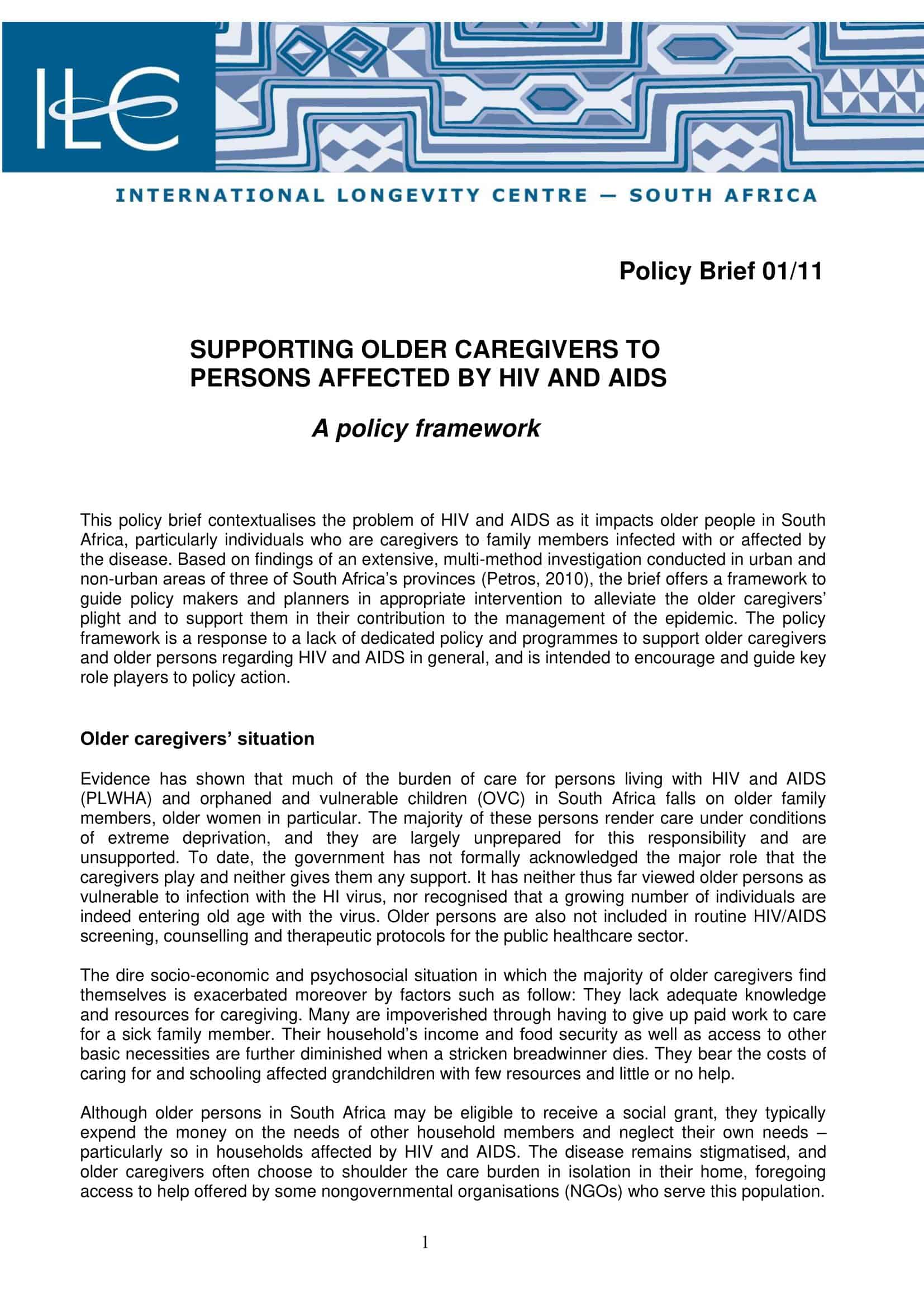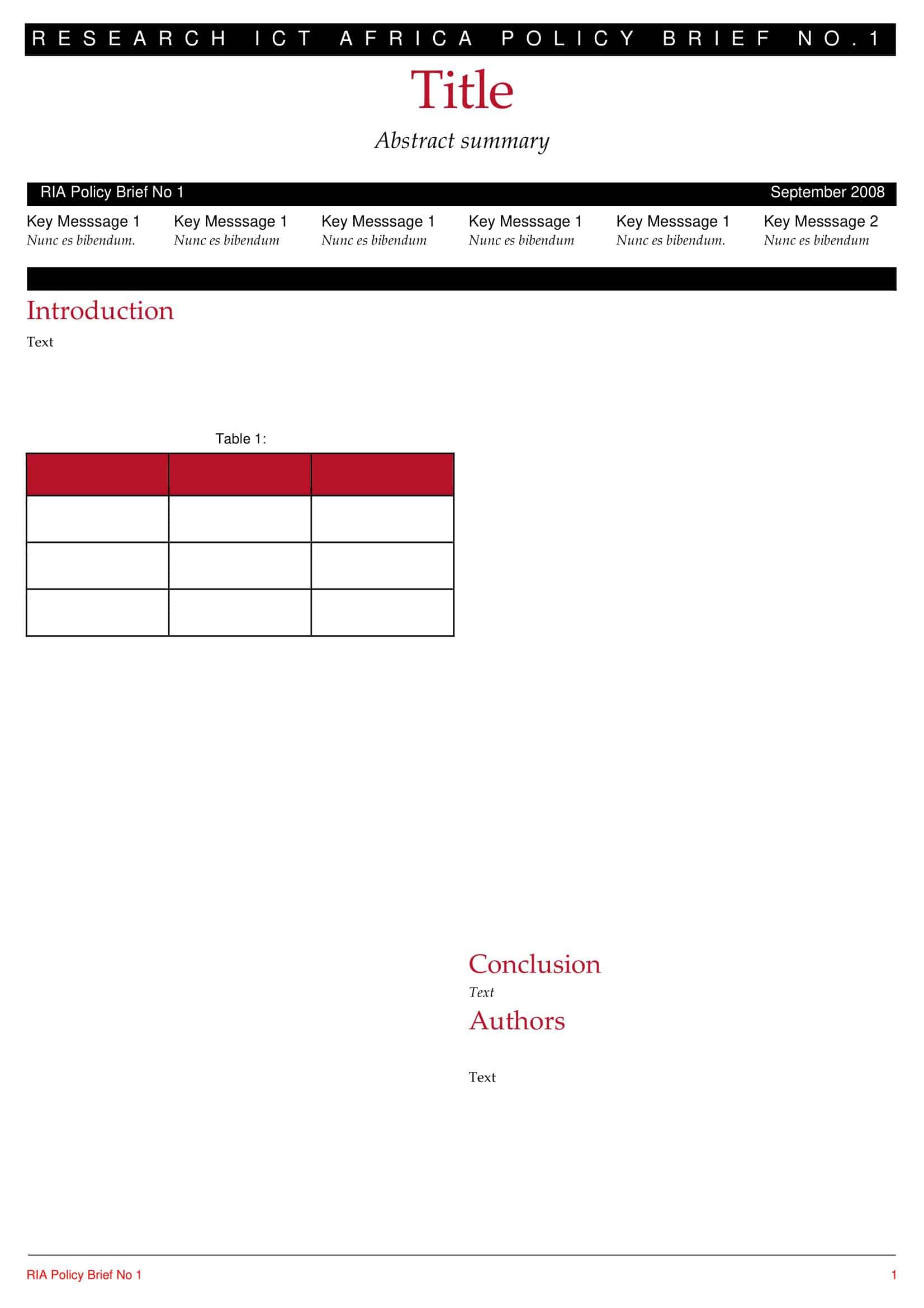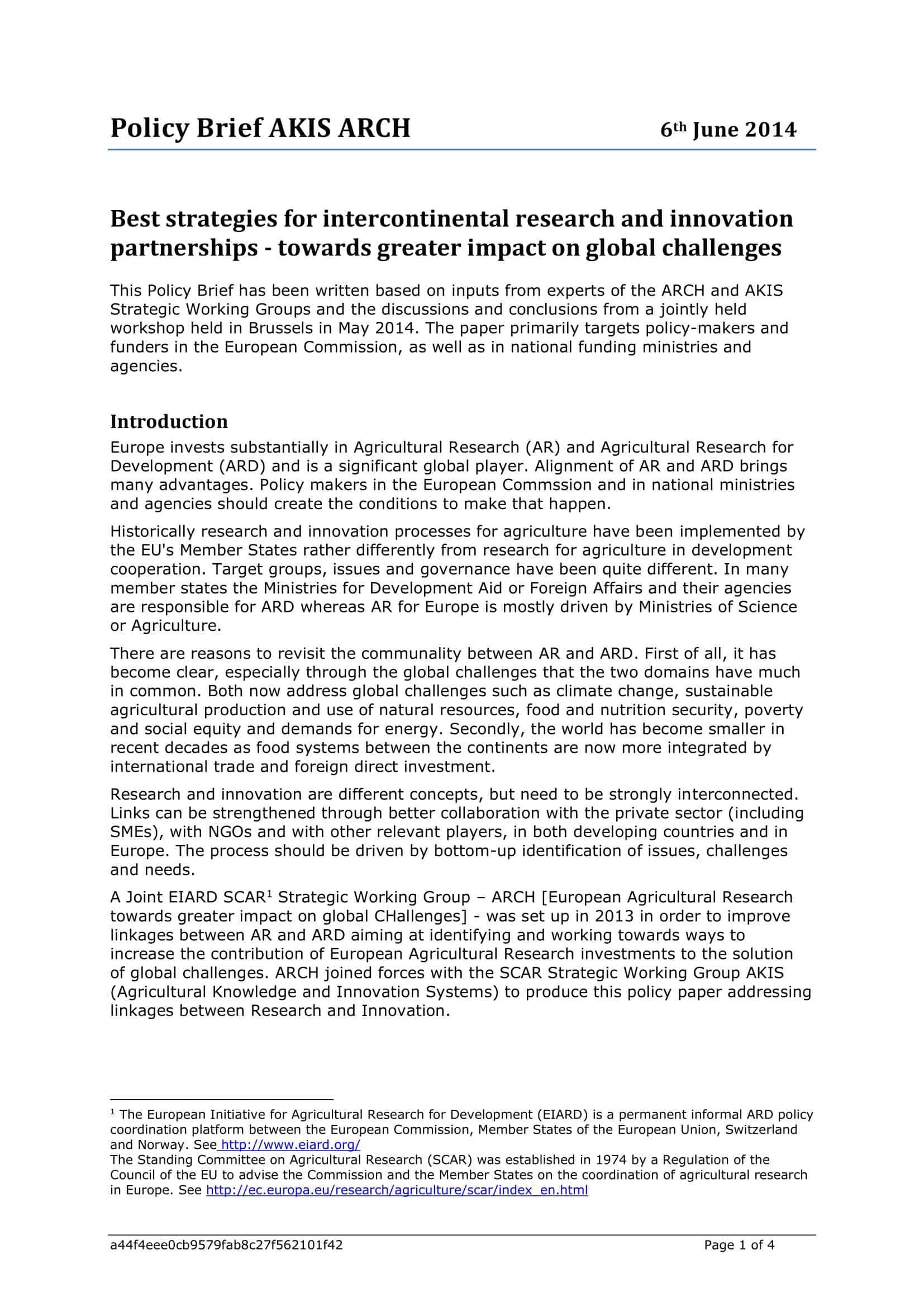A policy brief format can be found in diverse variations. It may be employed for internal corporate interactions, institutional procedures, or governmental operations. The substance of a policy brief sample hinges on its intended application and objective. Nonetheless, a consistent feature across all policy briefs is the presentation of well-considered recommendations aimed at tackling pertinent concerns.
Table of Contents
What is a policy brief?

A policy brief is a concise, focused document that presents clear arguments, evidence, and recommendations to address a specific issue or problem. It is designed to inform and influence policymakers, stakeholders, or decision-makers by providing them with relevant facts, analysis, and actionable solutions.
Policy briefs are used in various contexts, such as government, non-governmental organizations, think tanks, and businesses, to communicate complex information in an easily digestible and persuasive manner. The goal of a policy brief is to enable informed decision-making and promote the adoption of effective policies or strategies to address the identified issue.
Policy Brief Templates
“Policy Brief Templates” are pre-designed documents that provide a structured format for presenting concise and informative summaries of policy issues, proposals, or recommendations. These templates serve as valuable tools for policymakers, researchers, or organizations to effectively communicate key policy insights and influence decision-making processes.
Policy briefs are concise documents that distill complex policy topics into clear, accessible language. They provide an overview of the policy problem, present evidence-based analysis, and propose recommendations or solutions. Policy brief templates offer a standardized layout that helps ensure the information is presented in a logical and compelling manner.
Policy brief templates typically include sections for an executive summary, background information, key findings or analysis, policy options, and recommendations. They may also include visual aids such as charts, graphs, or infographics to enhance understanding and highlight key data points.
Why are policy briefs important?
Policy briefs are important for several reasons:
Inform decision-making: Policy briefs provide decision-makers with concise, evidence-based information and recommendations that help them understand complex issues and make informed choices.
Influence policy: By presenting well-researched arguments and practical solutions, policy briefs aim to influence policymakers and stakeholders to adopt policies or strategies that address the identified issue effectively.
Bridge the knowledge gap: Policy briefs serve as a critical link between research, academia, and policy formulation, translating complex research findings into accessible language and actionable recommendations for policymakers.
Raise awareness: Policy briefs help raise awareness of pressing issues and challenges among the general public, media, and various stakeholders, fostering discussion and debate that can lead to policy change.
Advocate for change: Policy briefs can be used by advocacy groups, non-governmental organizations, and other stakeholders to build support for their cause and push for the implementation of specific policies or interventions.
Facilitate communication: Policy briefs foster communication and collaboration between different sectors, organizations, and individuals by presenting a common understanding of the issue and potential solutions.
Monitor progress: By presenting data, research, and recommendations, policy briefs can help track the progress of existing policies or interventions and identify areas for improvement.
Overall, policy briefs play a crucial role in shaping public policy by providing well-researched, evidence-based information and recommendations that help decision-makers and stakeholders address pressing issues and challenges effectively.
How to Structure a Policy Brief
A well-structured policy brief typically includes the following elements:
Title: Create a concise and informative title that reflects the main issue or topic addressed in the policy brief.
Executive Summary: Provide a brief overview of the policy brief’s content, summarizing the issue, key findings, and recommendations. This section should be short and easily digestible, giving readers a clear understanding of the brief’s purpose and main points.
Introduction: Introduce the issue or problem being addressed, explaining its relevance and importance to the target audience, such as policymakers or stakeholders. Establish the context and background information necessary for readers to understand the issue.
Problem Statement: Clearly define the specific problem or challenge that the policy brief addresses. Explain the causes, consequences, and scope of the problem, providing evidence and data to support your claims.
Policy Options or Solutions: Present the proposed policy options or solutions to address the issue. Describe each option, outlining its advantages, disadvantages, and potential impacts. Use evidence and research to support your recommendations, highlighting the effectiveness and feasibility of each proposed solution.
Analysis and Comparison: Analyze and compare the policy options, discussing their strengths and weaknesses, as well as any trade-offs or potential unintended consequences. This section should provide a balanced assessment of each option, helping readers understand the benefits and drawbacks of the proposed solutions.
Recommendations: Clearly state your preferred policy option or combination of options, based on the analysis and comparison. Explain the rationale behind your recommendation and outline the steps required for its implementation. This section should provide actionable guidance for decision-makers and stakeholders.
Conclusion: Summarize the main points of the policy brief, reiterating the problem, proposed solutions, and recommendations. Reinforce the importance of addressing the issue and the potential benefits of implementing the recommended policy option.
References and Further Reading: List any sources cited in the policy brief and provide suggestions for further reading, if applicable. This section helps establish the credibility of your research and allows interested readers to explore the topic in greater depth.
Distinctive Features of a Policy Brief Format
Various policy brief samples can be found across multiple academic fields, and due to the absence of a standardized policy brief format, the content within these documents can differ significantly. Policy briefs are distinct from other written assignments in several aspects:
Target Audience
Different documents or writing tasks cater to distinct audiences. A policy brief format is designed for a general readership, often with a focus on policymakers who share concerns related to the subject matter of the brief.
Language Employed
While most academic disciplines discourage the use of excessive technical terms, clarity of language is of particular importance in policy briefs. Eschew jargon in favor of straightforward language to ensure that your document is easily comprehensible to all readers.
Objective
The primary aim of a policy brief is to convey the practical implications of research to its audience. This entails utilizing the researched information for a specific goal, assisting readers in determining the appropriate course of action. A policy brief connects current research to existing policies, accentuating the application of research findings rather than assessing research methods. Although research papers and other academic documents might also offer recommendations for practical actions, policy briefs place a stronger emphasis on these aspects, as they are more thoroughly developed within the document.
How to Write a Policy Brief: A Comprehensive Step-by-Step Guide
Crafting an effective policy brief is an essential skill for anyone looking to influence policy decisions or engage in constructive dialogue with policymakers and stakeholders. A policy brief is a concise, focused document that presents clear arguments, evidence, and recommendations to address a specific issue or problem.
This comprehensive guide will provide step-by-step instructions on how to write a persuasive policy brief, from identifying the issue and researching the background to developing actionable recommendations and presenting them in a coherent, accessible manner. Whether you are a student, researcher, policymaker, or advocacy professional, following these steps will help you create a compelling policy brief that can inform decision-making and drive meaningful change. Here are stepts:
Step 1: Identify the issue
Choose a specific and relevant issue or problem that you want to address in your policy brief. Ensure that the topic is timely and of interest to policymakers or stakeholders.
Step 2: Research and gather evidence
Conduct thorough research on the issue, gathering relevant data, facts, and evidence to support your arguments. Review existing policies, legislation, and previous research to provide context and background information for your policy brief.
Step 3: Define your target audience
Identify the primary audience for your policy brief, such as policymakers, stakeholders, or the general public. Tailor your language, tone, and content to suit the needs and interests of your target audience.
Step 4: Develop policy options or solutions
Based on your research, propose well-reasoned policy options or solutions to address the issue. Consider the feasibility, effectiveness, and potential impacts of each option, and support your recommendations with evidence and analysis.
Step 5: Organize and structure your policy brief
Outline the structure of your policy brief, organizing the content into logical sections, such as the introduction, problem statement, policy options, analysis, recommendations, and conclusion. Ensure that your policy brief follows a clear and coherent structure that guides the reader through the document.
Step 6: Write the policy brief
Begin writing the policy brief, using clear, concise language and avoiding jargon or overly technical terms. Present your arguments and evidence in a persuasive manner, focusing on the practical implications and actionable recommendations. Include visual aids, such as graphs, charts, or illustrations, to support your points and make the information more engaging and accessible.
Step 7: Include an executive summary
Write a brief executive summary that provides an overview of the policy brief’s content, summarizing the issue, key findings, and recommendations. This section should be short and easily digestible, giving readers a clear understanding of the brief’s purpose and main points.
Step 8: Edit and revise
Review your policy brief, checking for clarity, coherence, and accuracy. Ensure that your arguments are well-supported, your recommendations are practical and feasible, and your language is clear and accessible. Revise and edit your policy brief as needed to improve its quality and effectiveness.
Step 9: Add references and further reading
Include a list of sources cited in the policy brief and provide suggestions for further reading, if applicable. This section helps establish the credibility of your research and allows interested readers to explore the topic in greater depth.
Step 10: Seek feedback and finalize
Share your policy brief with colleagues, mentors, or experts in the field for feedback and suggestions. Use their input to refine and strengthen your policy brief, ensuring that it is well-researched, persuasive, and actionable. Once your policy brief is finalized, distribute it to your target audience and promote its key findings and recommendations.
Crucial Elements to Consider When Crafting a Policy Brief
Having familiarized yourself with the fundamental structure and components of a policy brief, the following tips will ensure your brief is even more effective by taking these important factors into account.
Define Your Audience:
Tailoring your message to your target audience is essential. Take into account the political preferences and past actions of your readers to adjust your writing accordingly, emphasizing aspects that your readers would find significant and persuasive.
Hone Your Central Message:
Maintain a clear focus on the core issue you’re addressing. Although it may be tempting to delve into related problems, stay on track by concentrating on data and details directly leading to your proposed solution.
Establish Relevance and Urgency:
To encourage readers to take action, the issue presented in your policy brief should be both relevant and urgent. Ensure your brief implicitly or explicitly answers the questions “Why should I care?” and “Why now?”
Provide Essential Background Information:
Include sufficient context to help readers understand the issue. Offer a concise summary of crucial background information, highlighting contributing factors and the broader implications of your proposed solutions.
Choose Impactful Statistics:
While an abundance of statistics may seem supportive, too many can overwhelm the brief. Carefully select the most significant stats that best reinforce your solution.
Ensure Clarity and Comprehensibility:
Avoid excessive jargon, academic language, or lengthy sentences and paragraphs. Edit your text to simplify language and break up large blocks of content, making your message as straightforward and accessible as possible.
Align Visuals with the Message:
Carefully choose and place visuals that complement your message. The images should provide an overview of the main issue, similar to the title. If there is any inconsistency between the writing and images, it can muddle the message.
FAQs
Who is the target audience for a policy brief?
The target audience for a policy brief can include policymakers, stakeholders, decision-makers, or the general public. The audience may vary depending on the issue being addressed and the purpose of the brief.
How long should a policy brief be?
A policy brief should be relatively short, usually ranging from 2 to 8 pages. The length may vary depending on the complexity of the issue and the amount of information required to convey the main points effectively.
How can I make my policy brief more persuasive?
To make your policy brief more persuasive, ensure that your arguments are well-reasoned, supported by evidence, and targeted towards the interests of your audience. Use clear and concise language, avoid jargon, and incorporate visuals to enhance understanding.
What types of sources should I use when researching for a policy brief?
Use reliable and reputable sources, such as peer-reviewed articles, government reports, and data from reputable organizations. Cite your sources appropriately to support your arguments and lend credibility to your brief.
How do I know if my policy brief is effective?
An effective policy brief should be clear, concise, and persuasive. It should clearly identify the issue, provide evidence-based recommendations, and present a compelling argument for the proposed solutions. Seek feedback from colleagues or experts in the field to refine your brief and ensure it meets these criteria.
Can I use visuals in my policy brief?
Yes, using visuals such as graphs, charts, and illustrations can enhance the understanding and impact of your policy brief. Ensure that the visuals are relevant, easy to understand, and well-integrated into the text.















































































![Free Printable Roommate Agreement Templates [Word, PDF] 1 Roommate Agreement](https://www.typecalendar.com/wp-content/uploads/2023/06/Roommate-Agreement-150x150.jpg)
![Free Printable Credit Card Authorization Form Templates [PDF, Word, Excel] 2 Credit Card Authorization Form](https://www.typecalendar.com/wp-content/uploads/2023/06/Credit-Card-Authorization-Form-150x150.jpg)
![Free Printable Stock Ledger Templates [Excel,PDF, Word] 3 Stock Ledger](https://www.typecalendar.com/wp-content/uploads/2023/08/Stock-Ledger-150x150.jpg)
